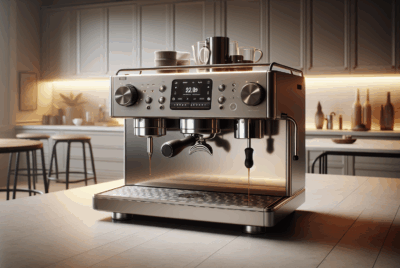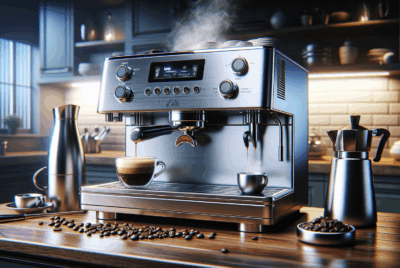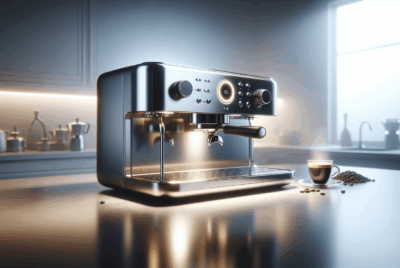Semi Automatic vs Automatic Espresso Machine: Understanding Key Differences
As an Amazon Associate, I earn from qualifying purchases, at no additional cost to you. Disclaimer
Deciding between a semi-automatic and an automatic espresso machine can feel overwhelming.
The key difference is the level of user control you want over the brewing process.
Semi-automatic machines give me more direct involvement by letting me control the extraction time. This allows for personal touches and minor adjustments, perfect for coffee enthusiasts like me.

Automatic espresso machines, on the other hand, simplify my routine. They handle the timing automatically, which means I can prepare espresso with just the press of a button. This is ideal if my mornings are rushed and I want consistent results without much effort.
Both types have their own appeal depending on my lifestyle and preferences.
By knowing what I need from my coffee-making experience, I can choose the machine that best fits me.
History and Evolution of Espresso Machines

Espresso machines have transformed remarkably since their inception. Starting with manual machines, the journey has led to fully-automatic versions, each stage marked by innovation and improvement.
The Invention by Angelo Moriondo
I learned that the history of espresso machines traces back to 1884 when Angelo Moriondo from Italy patented the first-ever espresso machine. His invention used steam and water to brew coffee quickly, a groundbreaking idea at that time. This machine marked the beginning of espresso technology and paved the way for further developments in coffee brewing.
This initial design was large and not very user-friendly, unlike today’s more compact machines. Moriondo’s machine set a precedent, inspiring inventors to make espresso more accessible. Though his machine was innovative, it wasn’t intended for commercial production. It remained a prototype, but it laid the groundwork for future advancements.
From Manual to Fully-Automatic Espresso Machines
The transition from manual to automatic espresso machines reflects significant technical advancements.
Manual machines, controlled entirely by the user, require skill and precision. These machines gave way to semi-automatic ones, which introduced electric pumps for consistency and ease.
As I explore more, I see that automatic and super-automatic machines have become the standard today.
Automatic machines simplify the brewing process by managing water flow themselves. Super-automatic models take it further, grinding beans, brewing coffee, and even frothing milk, all at the push of a button, offering convenience that aligns with modern lifestyles.
Understanding Espresso and Espresso Machines
When discussing espresso and espresso machines, details matter. I explore what defines espresso and the main types of machines used to brew it.
Defining Espresso
Espresso is a strong, rich coffee brewed by forcing hot water through finely-ground coffee beans. This coffee is known for its thick consistency and bold flavor. It appears with a golden layer on top, known as crema, which adds to its complexity.
The taste of espresso largely comes from the beans, roasting time, and pressure at which it’s brewed. A typical shot is small but concentrated. Each sip provides a mix of aromas and flavors that many coffee lovers appreciate. Remember, brewing a perfect espresso requires practice and precision.
Main Types of Espresso Machines
Different types of espresso machines are available, each with unique features.
Manual machines allow users to control every aspect of the brewing process, but they need skill to operate. These are for those passionate about hands-on control.
Semi-automatic machines strike a balance between manual work and convenience. They let me control the water flow but automate temperature and pressure.
Automatic machines handle most functions automatically. This makes them user-friendly, especially for those who want consistency without much effort.
Super-automatic machines go a step further by grinding beans, brewing, and cleaning with just a button press. Each type offers a different experience in crafting a perfect espresso.
Comparing Automatic and Semi-Automatic Espresso Machines
When it comes to espresso machines, you often have to choose between automatic and semi-automatic options. These machines differ in how they function, their ease of use, and their level of control. Let’s explore these…
Key Differences in Functionality
With automatic espresso machines, much of the process is handled by the machine. I only need to press a button to get a cup of espresso. The water flow and shot timing are managed automatically. This makes the process quite simple.
In contrast, semi-automatic espresso machines give me more control. I have to manually start and stop the espresso extraction. This means I can influence the flavor and strength more precisely. This takes a bit more practice and skill to get it just right.
Pros and Cons of Each Machine Type
Automatic espresso machines are user-friendly. They are great for anyone who wants quick and fuss-free espresso. Since the machine does most of the work, I don’t have to worry much about messing up.
On the other hand, semi-automatic espresso machines allow me to customize each shot. They offer more control if I’m willing to put in the time to learn. The process can be rewarding but might not be ideal for beginners or when I’m in a hurry.
Pros:
- Automatic: Convenience, Ease of Use
- Semi-Automatic: Customization, Control
Cons:
- Automatic: Less Control, Limited Customization
- Semi-Automatic: Learning Curve, Time-Consuming
The Brewing Process and Espresso Quality

In making espresso, both the process and machine type greatly impact the final cup. Factors like grinding, tamping, and brewing parameters determine taste and quality.
From Grinding to Brewing
I start with grinding the coffee beans. A consistent grind is crucial because it affects the flow of water through the coffee.
For both semi-automatic and automatic machines, the grind size should be fine but not too fine. I always check that my grinder is set correctly for this.
Next, I move on to tamping. This step compresses the ground coffee evenly to ensure water passes through at just the right rate. I need consistent pressure for the best espresso shots. With an automatic machine, some of this process might be adjusted automatically.
Brewing involves water passing through the tamped coffee. Semi-automatic machines offer control over brewing time and pressure, affecting the espresso’s taste profile. I monitor these elements closely to maintain the quality of my espresso shots.
Factors Affecting Espresso Quality
Several factors influence the quality of the espresso shot I brew.
Grind size and consistency are key. The extraction time matters, too. I aim for a balance to avoid under or over-extraction.
Another crucial factor is tamping pressure. Uneven tamping can result in poor-quality shots. Both grind and tamp must work together harmoniously.
Brewing parameters such as water temperature and pressure also affect the espresso. Different machines can vary, but I focus on maintaining the optimal settings. Ensuring these factors align results in a high-quality cup.
Machine Components and Their Impact

The components of espresso machines greatly influence their performance. From temperature control to grinding size and portafilter type, each part plays a crucial role in making the perfect espresso.
Boilers and Temperature Control
Temperature control is critical for brewing quality espresso.
Semi-automatic machines often use single boilers or heat exchangers. These can lead to slight temperature variations. With a single boiler, I may need to wait between steaming milk and brewing espresso because one process impacts the other.
Automatic machines, on the other hand, often have dual boilers. This lets me brew and steam at the same time, maintaining more consistent temperatures. Because of this setup, I find espresso is less likely to be sour or bitter. This precision can make a big difference in taste.
Grinders and Grind Size
The size of the coffee grind significantly affects extraction. Some machines have built-in grinders, which can offer the convenience of grinding coffee right before brewing.
Semi-automatic machines might require a separate grinder, giving me more control to adjust the grind size based on my coffee beans or taste preferences.
Automatic machines with built-in grinders often have settings for grind size. This ensures consistency each time. Fresh grind helps maintain the coffee’s flavor and aroma. When grind size is not right, espresso can be either over-extracted or under-extracted, leading to a less satisfying taste.
Portafilters and Tamping
A portafilter holds the coffee grounds during brewing. It’s crucial because it affects water flow through the coffee.
Many machines come with pressurized portafilters, which may help make brewing easier but might not allow for much control over the result.
Tamping evenly compresses the coffee grounds, which influences extraction. Some automatic machines perform pressure-based tamping for consistent results. In contrast, semi-automatic machines might require manual tamping. I think that using the right pressure and technique ensures each shot has balanced flavors and a good crema.
Ease of Use and Maintenance

When choosing between semi-automatic and automatic espresso machines, ease of use and maintenance are key considerations. The machines differ in how simple they are to operate, as well as in how much effort is needed for cleaning and upkeep.
Daily Operation and Learning Curve
With semi-automatic machines, I find that they provide more control over the brewing process. This requires me to manually stop the flow of water. It’s a bit like brewing a personal cup. Due to this manual control, there is a learning curve. It can take time for me to master making the perfect espresso.
Automatic machines simplify the process. I push a button, and the machine takes care of everything. This means I need less experience to achieve consistent results. Automatic machines are great if I’m looking for quick and easy coffee-making with minimal effort. Despite this simplicity, I have less control over the final product.
Cleaning and Durability
Cleaning is an important task to ensure the machine lasts a long time.
Semi-automatic machines often have removable parts. This allows me to clean the machine thoroughly by reaching all areas. Regular cleaning ensures no coffee residue stays behind, which can affect the taste.
Automatic machines usually have built-in cleaning programs. I can start a cycle with a push of a button. While this is more convenient, I still need to maintain the machine by cleaning certain parts manually.
Both types of machines are built to last, but regular maintenance on my part keeps them in good condition. By taking care of my machine, I help prolong its life and enjoy better espresso.
Additional Features and Customization
When choosing between semi-automatic and automatic espresso machines, key features such as milk frothing abilities and programmable drink options can make a big difference in your coffee experience.
Milk Frothing Capabilities
I find milk frothing to be an essential feature for making delicious espresso-based drinks.
Semi-automatic machines usually come with a manual steam wand. This lets me froth milk to my liking, allowing for some customization in texture.
Meanwhile, automatic machines often offer auto-frothing systems. These systems produce consistent foam, saving me time and effort.
Some models even include adjustable settings for milk texture and temperature. This can be a plus for someone like me who enjoys precise control over my cappuccinos or lattes.
Programmable Drink Options and Profiles
Programmable drink options let me recreate my favorite coffee drinks with ease.
Semi-automatic machines may require more hands-on adjustments to meet my personal taste. I might need to manually adjust the grind size and brew time for different flavors.
In contrast, automatic machines often feature preset drink profiles. These profiles allow me to choose from a simple menu and customize my drink with just a few touches.
Some machines even let me save these settings for future use, ensuring consistency every time I brew. These features can enhance my daily coffee routine, offering both convenience and personalization.
Espresso Machines and Lifestyle Considerations
Choosing between semi-automatic and automatic espresso machines can impact your daily routine and kitchen space. I will explore how different machines fit into your lifestyle and personal coffee habits.
Counter Space and Kitchen Aesthetics
When picking an espresso machine, it’s important to think about available counter space and how the machine looks in your kitchen.
Super-automatic and fully-automatic machines tend to be larger and may require more room. If counter space is limited, I might consider a smaller option like a pod espresso machine or a compact manual model.
The look of the machine also matters. High-end machines can add a touch of elegance to a kitchen, becoming a stylish centerpiece.
Color and design can complement existing décor or stand out as a bold feature. A nice-looking espresso machine can even enhance my coffee-making experience. Considering both function and aesthetics can help ensure the machine fits in well with my kitchen setup.
Matching Machine to Usage Habits
My coffee habits should guide my choice of espresso machine.
If I am an espresso enthusiast who enjoys crafting each cup, a semi-automatic or manual machine could be a good fit. These options allow more control over brewing, which can be satisfying for those who love the ritual of making coffee.
For convenience, a fully-automatic or super-automatic machine makes sense. These types handle most tasks and are ideal if I prefer a quick, no-fuss process. They are great for busy mornings or when serving guests. By matching the machine to my lifestyle, I can enhance my coffee experience and ensure that it fits seamlessly into my daily routine.
Cost and Value for Money
When weighing cost and value in espresso machines, I consider both quality and budget. This can impact both how much I invest and how long my machine lasts.
Investing in Quality and Longevity
High-quality espresso machines often come with a higher price tag, but they can be a worthwhile investment.
I know that spending more upfront often leads to a longer lifespan. Premium machines use materials like stainless steel, which resist wear and tear. Over time, this means fewer repairs and replacements.
Semi-automatic machines usually require more involvement, which can enhance my experience. They might not have as many automatic features, but I enjoy the control over my espresso. Despite fewer features, they offer high durability.
Budget Considerations for Home and Commercial Use
My budget plays a key role in deciding between semi-automatic and automatic machines.
For home use, I find that semi-automatic machines can be more affordable. They still deliver quality and allow me to learn more about crafting espresso.
For commercial settings, I look at automatic machines. Though pricier, they offer speed and consistency, crucial for a busy cafe. Automatic machines reduce training time for staff, making them a practical choice.
Whether it’s for personal enjoyment or a business investment, I carefully balance cost against the value each type of machine offers.
Frequently Asked Questions
I explore key aspects of choosing between semi-automatic and automatic espresso machines. I’ve found the differences in control, home use suitability, preference among baristas, user experience, espresso quality, and considerations for brands like Breville to be particularly interesting.
What are the main differences between semi-automatic and automatic espresso machines?
Semi-automatic machines let me control the pump, allowing more precision in brewing. Automatic machines handle the timing, making it easier to use. It comes down to whether I want more control or more convenience in my espresso-making process.
Are semi-automatic or automatic espresso machines better for home use?
For home use, it often depends on my personal preferences.
If I enjoy tinkering with settings and learning about the brewing process, a semi-automatic might be better. If I prefer a quicker, more straightforward experience, an automatic machine could be more suitable.
What makes semi-automatic espresso machines a popular choice among baristas?
Baristas often choose semi-automatic machines because they offer more control over the brewing process. I can adjust the brew time and influence the flavor of the espresso. This flexibility helps me fine-tune each shot to my liking.
How does the user experience vary between using semi-automatic and fully automatic espresso machines?
The experience with a semi-automatic machine involves more hands-on interaction, giving me a sense of involvement. A fully automatic machine provides ease and efficiency, handling most of the process for me. My choice depends on how involved I want to be in making my coffee.
Is there a notable difference in the quality of espresso produced by automatic versus semi-automatic machines?
Both types can produce high-quality espresso, but my technique and experience with semi-automatic machines can enhance taste.
Automatic machines offer consistency and ease, which is beneficial when I prefer less manual effort. The quality difference can often be subtle and subjective.
What should a buyer consider when choosing between a Breville semi-automatic and an automatic espresso machine?
When choosing between Breville’s semi-automatic and automatic machines, I consider my skill level, available time, and desire for manual control.
Breville offers a range of options, so I should look at features, budget, and ease of use to find the best fit for my lifestyle.



